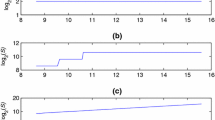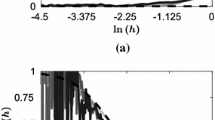Abstract
We extend the permutation largest slope entropy (PLSE) to the detection of strange nonchaotic attractors (SNA). The initial time series derived from a quasi-periodically forced chaotic map is first transformed into a series of symbols using the order relation. These symbols are thereafter combined into m-length words to obtain quantized ordinal matrices (QOM). Finally, the PLSE is applied to the series of QOM for detecting changes in the behavior of the system. Simulation results show that the QOM transform allows to control the complexity of the time series, hence to reduce the entropy of tori and SNA and to increase that of chaotic motions. This result allows to highlight transitions between the three types of motions, thus showing a nonzero entropy for SNA which nevertheless is smaller than that of chaotic dynamics. The approach is effective for the detection of different routes to SNA from time series.













Similar content being viewed by others
References
Abarbanel, H.D.I.: Analysis of Observed Chaotic Data. Springer, New York (1996)
Afsar, O., Bagei, G.B., Tirnakli, U.: Renormalized entropy for one dimensional discrete map: periodic and quasi-periodic route to chaos and their robustness. Eur. Phys. J. B 86, 307–320 (2013)
Bandt, C., Pompe, B.: Permutation entropy: a natural complexity measure for time series. Phys. Rev. Lett. 88, 174,102 (2002)
Barnett, W., Serletis, A.: Martingales, nonlinearity and chaos, journal of economic. Dyn. Control 24, 703–724 (2000)
Chaudhury, S., Smith, A., Anderson, B., Ghose, S., Jessen, P.: Deterministic nonperiodic flow. J. Atmos. Sci. 20, 130141 (1963)
Chaudhury, S., Smith, A., Anderson, B., Ghose, S., Jessen, P.: Quantum signatures of chaos in a kicked top. Nature 461, 768771 (2009)
Choe, G.: Computational Ergodic Theory. Springer, Berlin (2005)
Ding, M., Grebogi, C., Ott, E., Sauer, T., Yorke, J.A.: Estimating correlation dimension from a chaotic time series: when does it ocur? Phys. Rev. Lett. 70, 3872 (1993)
Eckmann, J.P., Ruelle, D.: Ergodic theory of chaos. Rev. Mod. Phys. 57, 617 (1985)
Fouda, J.S.A.E., Koepf, W.: Efficient detection of the quasi-periodic route to chaos by the three-state test. Nonlinear Dyn. 78, 1477–1487 (2014)
Fouda, J.S.A.E., Koepf, W.: Detecting regular dynamics from time series using permutations slopes. Commun. Nonlinear Sci. Numer. Simul. 27, 216–227 (2015)
Fouda, J.S.A.E., Effa, J.Y., Kom, M., Ali, M.: The three-state test for chaos detection in discrete maps. Appl. Soft Comput. 13, 4731–4737 (2013)
Fouda, J.S.A.E., Bodo, B., Djeufa, G.M.D., Sabat, S.L.: Experimental chaos detection in the duffing oscillator. Commun. Nonlinear Sci. Numer. Simul. 33, 259269 (2016)
Gao, J.B., Hu, J., Tung, W.W., Cao, Y.H.: Distinguishing chaos from noise by scale-dependent lyapunov exponent. Phys. Rev. E 74, 066,204 (2006)
Glas, L.: Introduction to controversial topics in nonlinear science: Is the normal heart rate chaotic? Chaos 19, 0285,014 (2009)
Gopal, R., Venkatesan, A., Lakshmanan, M.: Applicability of the 0–1 test for strange nonchaotic attractors. Chaos 23, 023,123 (2013)
Gottwald, G.A., Melbourne, I.: On the implementation of the 0–1 test for chaos. SIAM J. Appl. Dyn. Syst. 8, 129145 (2009)
Grassberger, P., Procaccia, I.: Characterization of strange attractors. Phys. Rev. Lett. 50, 346349 (1983)
Grassberger, P., Procaccia, I.: Estimation of the kolmogorov entropy from a chaotic signal. Phys. Rev. A 28, 2591–2593 (1983)
Heagy, J.F., Hammel, H.: The birth of strange nonchaotic attractors. Phys. D 70, 140–153 (1994)
Lindner, J.F., Kohar, V., Kia, B., Hippke, M., Learned, J.G., Ditto, W.L.: Strange nonchaotic stars. Phys. Rev. Lett. 114, 054,101 (2015)
Negi, S.S., Prasad, A., Ramaswamy, R.: Bifurcations and transitions in the quasiperiodically driven logistic map. Phys. D 145, 1–12 (2000)
Nishikawa, T., Kaneko, K.: Fractalization of a torus as a strange nonchaotic attractor. Phys. Rev. E 54, 6114–6124 (1996)
Pincus, S.M.: Approximate entropy as a measure of system complexity. Proc. Natl. Acad. Sci. 88, 2297–2301 (1991)
Prassad, A., Mehra, V., Ramaswamy, R.: Intermittency route to strange nonchaotic attractors. Phys. Rev. Lett. 79, 4127–4130 (1997)
Regev, O.: Chaos and Complexity in Astrophysics. Cambridge University Press, New York (2006)
Richman, J., Moorman, J.: Physiological time-series analysis using approximate entropy and sample entropy. Am. J. Phys. Heart C. 278, H2039–H2049 (2000)
Acknowledgments
This work was supported by the Alexander von Humboldt Foundation.
Author information
Authors and Affiliations
Corresponding author
Rights and permissions
About this article
Cite this article
Eyebe Fouda, J.S.A. Applicability of the permutation largest slope entropy to strange nonchaotic attractors. Nonlinear Dyn 87, 1859–1871 (2017). https://doi.org/10.1007/s11071-016-3158-6
Received:
Accepted:
Published:
Issue Date:
DOI: https://doi.org/10.1007/s11071-016-3158-6




